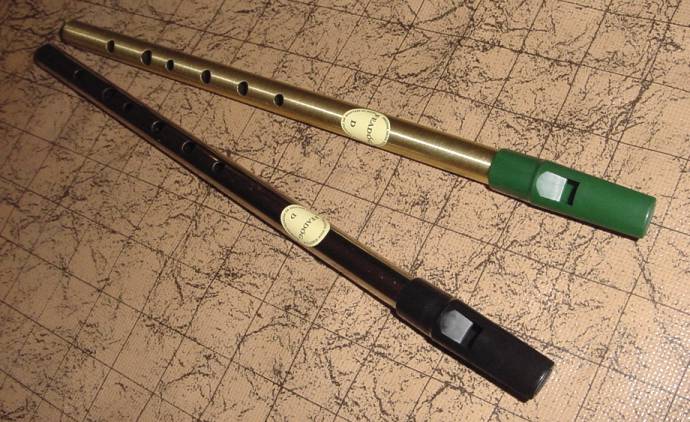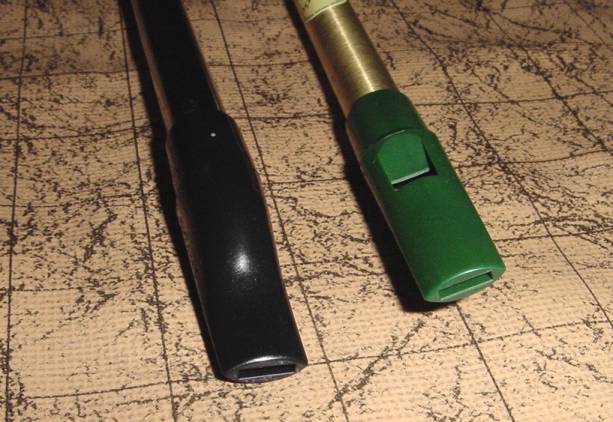Feadóg soprano D (Mark III) Review
(Review written May 2004)
- Preface
-
A little while back, a swell guy named Paul from the Feadóg Teoranta company offered to send me some whistles to review. I jumped at the chance. I've been meaning to do a review of an inexpensive whistle, since I think that more people own and play the less expensive models than do the high-enders. As Paul tells me in his letter, they are now on the Mark III version of the whistle since 2001.
According to Paul, the Feadóg is the oldest commerically produced whistle in Ireland, and is endorsed by Sémus MacMathúna (Music Officer of CCE, dedicated to promoting Irish music, dance, language and culture) and also by Rob Ó'Geíbheannaigh (Sinead O'Connor's whistler). Sounds pretty impressive to me.
- At a Glance
- Whistle Reviewed
- Feadóg soprano D (Mark III)
- Models Available
- soprano in nickel and brass, keys of C and D
- How Acquired
- Product sample from the Feadóg Teoranta.
- Construction
- Brass (with or without nickel plating) with plastic mouthpiece.
- Price at Time of Review (in US Dollars unless otherwise noted)
- approx $7.50
- Available From
-
the Feadóg Teoranta.
Lark in the Morning
The Whistle Shop
Lollysmith
- Appearance
- Feadógs look similar in appearance to many of the inexpensive whistles you may meet. it's got a simple metal tube (brass or nickel-plated) and a plastic mouthpiece. At first glance, it looks similar to a Waltons, Soodlum, or a Generation Folk Whistle. But there are some subtle differences...The mouthpiece design on the Feadóg looks pretty smooth. No angular sharp bumps anywhere. They've also taken care to remove the 'flashing' (the little nubbins left over when something is molded in plastic). The brass whistle has a nice brushed finish, rather than just being slick brass, and it looks quite nice. The nickel feels a lot heavier. Me, I prefer the brass.
-

Here are both kinds of D whistle. The brushed finish on the brass was picked up pretty good with my digital camera, though it shows up better on a much bigger picture! That brushed finish gives a couple of advantages: it doesn't pick up fingerprints, and it makes for a firm grip. I've never much cared for nickel whistles, because they're so slippery. Especially if your hands are moist (like you just put down your Guinness!). The brass doesn't suffer that problem, and the brushed finish makes it even more secure in your hands.
Here's the mouthpiece. The windway is straight and squared, as you can see here, and the labium ramp is long with a gradual angle. With long-beaked whistles like this, I still have the tendency to stabilize them with my teeth. The brass and nickel mouthpieces look identical in construction, if not color. Paul tells me that the nickel version of the Feadóg starts off as a Brass and is then plated, so the playing characteristics are very similar among them. I'll only highlight the differences I've noted.
- Playing Characteristics
- This whistle has that traditional 'pure drop' sound. People who love Generation whistles and old recordings of the masters will love this whistle. The tone isn't pure and flutey, it's a little rough (in a good way) and whistle-y. Personally, I wouldn't spend time and effort hunting for a 'good' Generation after playing the Feadóg.
-
Sound clips of the whistle:
Blarney Pilgrim
Video clips of the whistle:
Maid Behind the Bar (recorded 2017 on a classic Feadóg )Volume: This whistle is medium-range volume. Just right for your average session. The nickel seems just a touch louder to me. But only just a touch.
Responsiveness: Lightning fast. The brass, especially, with it's stay-put grip, makes fast tunes and ornaments roll off the fingers. This whistle could easily take everything I threw at it...the crans on the recording are the true test. A slow-responder will nearly always respond poorly on the bell note. This one was perfect. The nickel version feels slippery to me, so I tend to slow down because I feel like I'm going to drop it. I've never actually dropped a nickel whistle while playing it, but they always feel like it.
Tuning: Both the brass and the nickel had the exact same tuning, which leads me to believe that they're fairly consistent. If you've ever gone through dozens of Generations brand whistles looking for one of the fabled "good ones", you'll appreciate the fact that you don't have to with a Feadóg. Both whistles arrived tuned sharp. Fortunately, the headpiece is not glued on. It's on pretty tight, but with a little care and elbow-grease, I was able to move it so that A=440. After that, the whistle was in tune across it's range, which I find really rare in a lot of inexpensive whistles. Usually, I find that you've got to tweak a cheapie a little (a little duct tape here, enlarge a hole there) to make them decent. This one was in tune all the way across. The only down side here is that the second octave takes a lot more push to stay in tune than it takes to jump to the second octave. If you were tired or playing quiet, it'd be really easy to blow this whistle flat in the 2nd octave. You can get a lot of dynamic range on the whistle using breath control to push notes sharp and flat..+ or - 25 cents or so! Less so in the second octave, because of the push required.
C-natural: OXXOOO produces a pretty good c-natural about 7 cents sharp with my expected breath control, but easily brought in tune with a little breath adjustment. Over time, such breathing would become natural.
Hole size and placement: This whistle has holes are average size and placement. There are no weird spacings. If you can play a soprano D, you can play this one.
Air volume and pressure requirements: This whistle's a very easy player. You can jump the octave easily, and it doesn't take much breath. There's only the barest hint of back pressure..enough to let you're blowing into something, but not so much as to be really noticeable. It's really easy to just pick this thing up and go without too much thought.
Clogging: This whistle is middle-of-the-road when it comes to clogging. Most long-beaked straight-windway instruments (which means about every inexpensive whistle I've played) tend to clog on me after about 10-15 minutes of continuous playing. This one's no exception. It's pretty easy to clear, though and just keep going. I played it for a couple hours without it getting "waterlogged"--which is that point where clearing it is kind of pointless because it'll clog again before the next tune is over.
- Summary
- Great pure-drop traditional whistle. I can see why CCE likes them...they just have that Irish sound. It's even more amazing to find such a gem for less than $10.00. Because of the breath control needed, and the fact that it's easy to squeak the 2nd octave notes, I wouldn't call this a "beginner's" instrument. It would take a bit more effort to play well, and to master than some of the other cheap whistles out there. But what those whistles have in ease, this whistle beats hands-down in character.